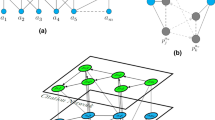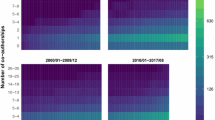Abstract.
Co-authorship networks of neighbouring scientific disciplines, i.e. granular (G) media and networks (N) are studied in order to observe drastic structural changes in evolving networks. The data is taken from ar**ves. The system is described as coupled networks. By considering the 1995–2005 time interval and scanning the author-article network evolution with a mobile time window, we focus on the properties of the links, as well as on the time evolution of the nodes. They can be in three states, N, G or multi-disciplinary (M). This leads to drastic jumps in a so-called order parameter, i.e. the link proportion of a given type, forming the main island, that reminds of features appearing at percolation and during metastable (aggregation-desaggregation) processes. The data analysis also focuses on the way different kinds (N, G or M) of authors collaborate, and on the kind of the resulting collaboration.
Similar content being viewed by others
References
R. Albert, A.-L. Barabási, Rev. Mod. Phys. 74, 47 (2002)
A.-L. Barabási, R. Albert, Science 286, 509 (1999)
R. Pastor-Satorras, A. Vespignani, Evolution and Structure of the Internet: A Statistical Physics Approach (Cambridge University Press, 2004)
S.-M. Yoon, K. Kim, e-print ar**v:physics/0503017
R.J. Williams, N.D. Martinez, Nature 404, 180 (2000)
A. Barrat, M. Barthelemy, R. Pastor-Satorras, A. Vespignani, Proc. Natl. Acad. Sci. USA 101, 3747 (2004)
M.E.J. Newman, Proc. Natl. Acad. Sci. USA 98, 404 (2001)
M.E.J. Newman, D.J. Watts, S.H. Strogatz, Proc. Natl. Acad. Sci. USA 99, 2566 (2002)
A.L. Barabási, H. Jeong, Z. Neda, E. Ravasz, A. Schubert, T. Vicsek, Physica A 311, 590 (2002)
J.J. Ramasco, S.N. Dorogovtsev, R. Pastor-Satorras, Phys. Rev. E 70, 036106 (2004)
E. Bruckner, W. Ebeling, A. Scharnhorst, Scientometrics 18, 21 (1990)
J.A. Holyst, K. Kacperski, F. Schweitzer, Ann. Rev. Comput. Phys. 9, 253 (2001)
F.Y. Wu, Phys. Rev. Lett. 22, 1174 (1969)
R.A. Blythe, J. Phys.: Conf. Ser. 40, 1 (2006)
D. Stauffer, A. Aharony, Introduction to Percolation Theory, 2nd edn. (Taylor and Francis, London, 1994)
H. Auradou, M. Zei, E. Bouchaud, Eur. Phys. J. B 44, 365 (2005)
C.J. Ellison, S.D. Kim, D.B. Hall, J.M. Torkelson, Eur. Phys. J. E 8, 155 (2002)
J. Rubi, A. Gadomski, Physica A 326, 333 (2003)
E.g. some “network papers" may not focus on complex networks, such as The response function of a sphere in a viscoelastic two-fluid medium by Levine and Lubensky (Phys. Rev. E 63, 041510 (2001)) which focuses on microrheology of polymer networks
R. Lambiotte, M. Ausloos, Phys. Rev. E 72, 066117 (2005)
M.E.J. Newman, Phys. Rev. E 64, 016132 (2001)
M.E.J. Newman, S.H. Strogatz, D.J. Watts, Phys. Rev. E 64, 026118 (2001)
M. Girvan , M.E.J. Newman, Proc. Natl. Acad. Sci. USA 99, 7821 (2002)
However, there are notable exceptions, such as the triplet made by (F. Coppex, M. Droz, A. Lipowski) who work together on both subjects (see ar**v:q-bio.PE/0312030 and ar**v:cond-mat/0205058 for instance), and form a small island
Noise is intrinsic to this sort of data as anyone having put a paper on the arxives knows
It can be observed from Figure [SEE TEXT]b that the number of nodes of type N is about 140 and G ca. 60, before event (2), and remains approximately the same after event (2), but since the island (I=2) is essentially made of G, the proportion of N in the main island falls to 0.40 (Fig. [SEE TEXT]a) after the event
M. Ausloos, R. Lambiotte, Phys. Rev. E 73, 11105 (2006)
E.A. Variano, J.H. McKoy, H. Lipson,Phys. Rev. Lett. 92, 188701 (2004)
R. Lambiotte, M. Ausloos, e-print ar**v:physics/0703266
G. Palla, A.-L. Barabási, T. Vicsek, Nature 446, 664 (2007)
R. Lambiotte, M. Ausloos, J.A. Holyst, Phys. Rev. E 75, 030101(R) (2007)
http://www.visone.de/
Author information
Authors and Affiliations
Corresponding author
Rights and permissions
About this article
Cite this article
Ausloos, M., Lambiotte, R. Drastic events make evolving networks. Eur. Phys. J. B 57, 89–94 (2007). https://doi.org/10.1140/epjb/e2007-00159-6
Received:
Published:
Issue Date:
DOI: https://doi.org/10.1140/epjb/e2007-00159-6




